#st perpetua
Text
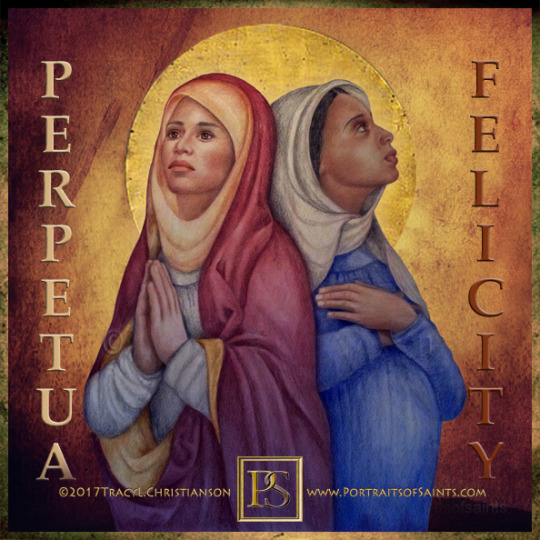
Saints Perpetua and Felicity
Died: 203
Feast Day: March 7 (New), March 6 (Trad)
Patronage: Mothers, Expectant Mothers, rangers, butchers, Carthage
Saints Perpetua and Felicity are Christian martyrs of the 3rd century. Perpetua (born around 181) was a 22-year old married noblewoman and a nursing mother. Her co-martyr Felicity, an expectant mother, was her slave. They suffered together at Carthage in the Roman province of Africa, during the reign of Septimius Severus.
Prints, plaques & holy cards available for purchase here: (website)
26 notes
·
View notes
Photo
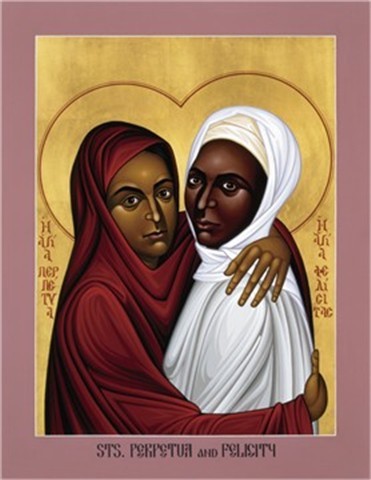
Sts. Perpetua and Felicity were North African friends martyred for their Christian faith in the amphitheater at Carthage. We know precise details of their imprisonment because Vibia Perpetua, a twenty-two year old of a distinguished noble family, kept a journal -- the first known written document by a woman in Christian history, with a concluding narrative by an eye-witness.
Artist: Br. Robert Lentz
#religion#christianity#saints#st perpetua and felicity#st perpetua#st felicity#icon#art#divinum-pacis
85 notes
·
View notes
Photo

#Print 'The Triumph of St. Perpetua' by Eric Gill (1928)
#Medium Wood engraving 3 1/2 × 3 1/4 (90 × 83) on thin Japan paper 9 1/2 × 5 (242 × 127)
#st perpetua#saint perpetua#the triumph of st perpetua#print#wood engraving#grabado#eric gill#1928#modern art#arte moderno#art#arte#contemporarydesign#contemporary art#visual art#visual arts#artes visuales#religious#religious art#christianity
33 notes
·
View notes
Text
you wanna know what confuses me?
anti-catholics are always going on about how we hate the LGBTQ+ community and how we're transphobic and all that "fun" stuff, but has anyone ever sat down to listen to Saints Perpetua and Felicity's story? They are literally known for being some of the first female martyrs and THEY ARE THE PATRONS OF SAME SEX RELATIONSHIPS!!!! THEY ARE THE UNOFFICIAL LESBIAN ICON OF CATHOLOCISM.
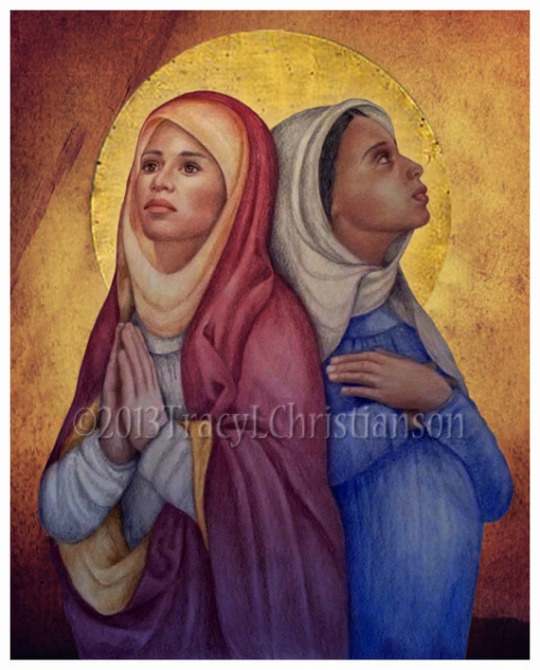
LOOK, THEY ARE IN LESBIANS FOR EACH OTHER!!!! i highly recommend looking into their story.
#lesbian#wlw#catholocism#St Perpetua#St Felicity#gay#trans#catholic#unofficial#they are in love#JUST LOOK AT THEM#martyrs#saints#pansexual#bisexual#sexuality#so cute
19 notes
·
View notes
Note
St Perpetua and Felicity (CANNOT BE SEPARATED) listen it’s the closest thing we will get to lesbians in the Catholic faith and if the gays get Saint Sebastian we deserve these girlies
they're both on the list!!!
3 notes
·
View notes
Text
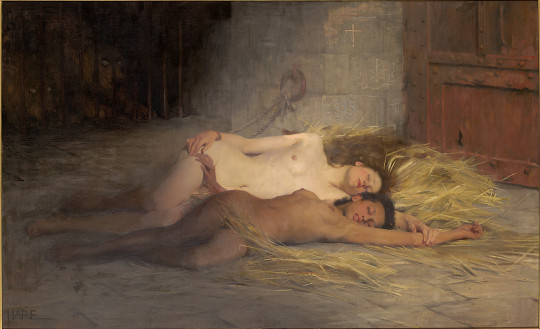
The Victory of Faith, St. George Hare, 1891, oil on canvas
48 notes
·
View notes
Text
SAINTS OF THE DAY (March 7)

Saints Perpetua and Felicity were martyrs who died for the faith around the year 203.
St. Perpetua was a young, well-educated, noblewoman and mother living in the city of Carthage in North Africa.
Her mother was a Christian and her father was a pagan. In terms of her faith, Perpetua followed the example of her mother.
Despite the pleas of her father to deny her faith, Perpetua did the very opposite and fearlessly proclaimed it.
At the age of 22, she was imprisoned for her faith. While in prison, she continued to care for her infant child and put up with the tortures designed to make her renounce her faith.
Perpetua remained steadfast until the end. St. Perpetua was sacrificed at the games as a public spectacle for not renouncing her faith.
St. Felicity was a pregnant slave girl who was imprisoned with St. Perpetua.
Little is known about the life of St. Felicity because, unlike Perpetua, she did not keep a diary of her life.
After imprisonment and torture, Felicity was also condemned to die at the games.
Only a few days before her execution, Felicity gave birth to a daughter, who was secretly taken away to be cared for by some of the Faithful.
3 notes
·
View notes
Text
Ideas for all-saint’s-day treats:
St. Lucy candy eyeballs
St. Apollonia tic-tacs
St. Joseph of Cupertino air heads
St. Francis animal crackers
St. Joan of Arc atomic fireballs
St. Moses of Ethiopia sour patch kids.
St. Ambrose bits-o’-honey
St. Perpetua cow tails
St. Anthony goldfish
St. Lawrence laffy taffy
St. Maximilian Kolbe peanut butter bars
St. Stephen pop rocks
St. Simeon the Stylite push-pops
St. John the Baptist crickettes
Saints Francisco and Jacinta of Fatima butterscotch discs
St. Isidore candy corn
St. Corbinian gummy bears
68 notes
·
View notes
Photo
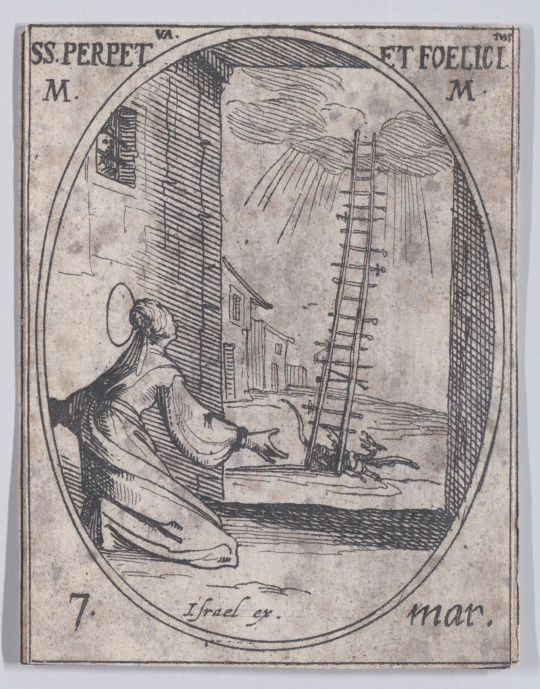
Ste. Perpétue et Ste. Félicité, martyres (St. Perpetua and St. Felicita, Martyrs), March 7th, from "Les Images De Tous Les Saincts et Saintes de L'Année" (Images of All of the Saints and Religious Events of the Year). 1636. Credit line: Purchase, Joseph Pulitzer Bequest, 1917 https://www.metmuseum.org/art/collection/search/420329
#aesthetic#art#abstract art#art museum#art history#The Metropolitan Museum of Art#museum#museum photography#museum aesthetic#dark academia
10 notes
·
View notes
Text
sigh. i'm so tired of dreams where i'm somehow back at my childhood church and trying to get out of there before i'm recognized and yelled at / attacked. i dream some iteration of this a few times a month.
they are interesting dreams though, because of how they shift and change.
sometimes the church looks like it does now, but more often it looks like it did when i was a kid / up through high school — they redid the entire sanctuary building while i was in undergrad (which is quite fitting narratively lol, that the building itself was demolished and remade while i was undergoing huge changes in myself off at college, so that what i returned to was never quite Familiar, an uncanny valley version of the place i loved most as a child)
the changes the church underwent:
they carefully removed the altar, crucifix, tabernacle, stained glass windows and tore down the old building, then placed all those treasured items in the new, larger sanctuary.
(a fun thing about that altar: it has relics of Felicity and Perpetua inside it, i.e. THE sapphic Saints)
The pews went from two straight rows to having some diagonal rows on the sides.
I want to say the floor is stone now instead of the old burgundy carpet that i remember so well growing up, and that is present in my parents' wedding photos
There are still the small gold fonts of holy water at the side doors, but the main entrance boasts a whole holy water fountain now which is pretty cool
all that statues and images of Jesus and co are, of course, white people. as it was as i grew up, so it is now. i just notice it way more now than i did then
my favorite addition is to one side, a shrine to Our Lady of the Wayside, which i wrote about years ago. I don't know what significance she has to whomever decided to give her space at St. Raphael, but her name alone is so queer — she's there with those who are left behind on the wayside, forgotten or abandoned or unable to keep up.
Sometimes in my dreams the old and the new tangle up, so that i'll exit the new sanctuary and find myself in the old gym, or the old behind-the-scenes space where i'd go to change into my altar serving alb, ready the candles, pray with the priest and other servers before Mass began. (I can't remember what the new behind-space looks like; i only ever went in there a handful of times. So it never shows up in my dreams)
Or in some of my dreams the church looks completely different from reality, expanded into a cathedral — last night the sanctuary looked similar to what it used to on its ground floor, but it had a second level wrapped around the sides for even more pews, with an enormous statue of Raphael in the very back watching over everything.
Most of the time I'm hiding. Fleeing. Trying to escape unseen. Sometimes it's the middle of Mass and i somehow accidentally ended up there? i'm hiding my face trying to hustle to the exit but they're all locked so i have to play it cool, act casual. Or else i'm lost in those back rooms with the albs and such; they've become labyrinthine and i keep passing the doorless spaces where they lead straight onto the raised space with the altar; i can see Father T preaching at the pulpit and my body goes cold fearing he'll turn his head and see me so i hurry on, still hopelessly lost
One time i spent the whole time kneeling before the place to the side of the altar in the old sanctuary building where the tabernacle used to be. Then when i was in high school they moved the tabernacle to be at a more central place right behind the altar, and moved statues of the Holy Family to fill its old space. In my dream the Holy Family and the tabernacle were there, and I knelt in prayer before them. I can't remember what I prayed. Was I desperate for safety or acceptance? Was I defiant? Did I pray for those who persecuted me? I don't remember, but I sure was at it a long time
Every now and then i dream someone does recognize me — and instead of attacking me, they say it's all right. That no one is mad. That i can come back without fear. I hate that version the most because when i wake up it takes me a moment to remember that didn't really happen
#log#pentecost incident#< if you don't know all The Drama that happened at my childhood church last year that's the tag to peruse lmao#church hurt /
13 notes
·
View notes
Photo

Saints Perpetua and Felicity
Died: 201
Feast Day: March 7 (New), March 6 (Trad)
Patronage: Mothers, Expectant Mothers, rangers, butchers, Carthage
Sts. Perpetua and Felicity are Christian martyrs of the 3rd century. Perpetua (born around 181) was a 22-year old married noblewoman and a nursing mother. Her co-martyr Felicity, an expectant mother, was her slave. They suffered together at Carthage in the Roman province of Africa, during the reign of Septimius Severus.
{website}
88 notes
·
View notes
Text

Nox Perpetua, an illustration i did for an exhibition, inspired by the italian folklore around St. Lucy
10 notes
·
View notes
Note
What’s your confirmation Saint? What are a few of your favorites or ones you feel especially connected to? I personal love Saints Perpetua and Felicity! Thank you and God bless you!! 🕊️💚
My confirmation saint was Bernadette. A few of my favorites are Servant of God Dorothy Day, Bl. Carlo Acutis, St. Therese of Liseux, St. Maria Goretti.
I’m realizing I like a lot of non canon saints.
19 notes
·
View notes
Text
Luke 11:14-23
Feast of Saints Perpetua and Felicity.

Sacra Conversazione with Mary & Child, St Felicity and St Perpetua,
Painted by an unknown hand, circa 1520,
Egg tempera and gold leaf on panel
© Natioanl Museum, Warsaw
Gospel Reading
Jesus was casting out a devil and it was dumb; but when the devil had gone out the dumb man spoke, and the people were amazed. But some of them said, ‘It is through Beelzebul, the prince of devils, that he casts out devils.’ Others asked him, as a test, for a sign from heaven; but, knowing what they were thinking, he said to them, ‘Every kingdom divided against itself is heading for ruin, and a household divided against itself collapses. So too with Satan: if he is divided against himself, how can his kingdom stand? – since you assert that it is through Beelzebul that I cast out devils. Now if it is through Beelzebul that I cast out devils, through whom do your own experts cast them out? Let them be your judges then. But if it is through the finger of God that I cast out devils, then know that the kingdom of God has overtaken you. So long as a strong man fully armed guards his own palace, his goods are undisturbed; but when someone stronger than he is attacks and defeats him, the stronger man takes away all the weapons he relied on and shares out his spoil.
‘He who is not with me is against me; and he who does not gather with me scatters.’
Reflection on the icon
Today we celebrate Saints Felicity and Perpetua. They are early Christian martyrs who died in Carthage, in the Roman province of Africa, on 7 March 203 AD. Perpetua was a young, well-educated noblewoman, and Felicity was a pregnant slave girl. Despite coming from different social backgrounds, they were united in their conversion to Christianity, a decision that led to their arrest during the reign of Emperor Septimius Severus (reigned 192-211 AD). At the time, the emperor had decreed a ban on conversions to Christianity, which he viewed as a threat to Roman religious traditions and authority.
The "Passion of Saint Perpetua, Saint Felicitas, and their Companions" (Latin: Passio sanctarum Perpetuae et Felicitatis) is an early Christian text that includes Perpetua's own diary, making it one of the oldest, most vivid, and most personal accounts of early Christian martyrdom. Along with the experiences of Perpetua and Felicity, the text also appears to contain, in his own words, the accounts of the visions of Saturus, another Christian martyred with Perpetua. An editor who states he was an eyewitness has added further accounts of the martyrs' suffering and deaths.
The Passio sanctarum Perpetuae et Felicitatis narrates their imprisonment, the visions Perpetua received while incarcerated, and the steadfastness of their faith despite the pleas of their families and the threat of a brutal death in the arena. Felicity, who was eight months pregnant at the time of her arrest, gave birth to a daughter while in prison, just days before her execution. Together, they were subjected to public humiliation and were ultimately killed by wild animals and gladiators.
Our early 16th century icon painting depicts the Coronation of Our Lady. She is seen holding the Christ child with one arm and in the other she is holding an apple, referencing to Mary as the New Eve and her role in the story of salvation. We see saint Felicity on the left, pregnant; on the right stands Perpetua holding the book of the Passio sanctarum writings. Both are seen resting on a large sword, the instrument of their martyrdom.
Saints Felicity and Perpetua. Pray for us.
Article by Father Patrick van der Vorst
#christian blog#jesus#bible reading#christian doctrine#bible scripture#biblical#glorytogod#bible#faith in jesus#bible study#mother mary#spirit of god#faith in god#gospel#godly living#kingdom of heaven#follow jesus#baby jesus#bible verse#christian faith#catholic#read your bible#belief in jesus#bible devotions#artists#artwork#art history#art#religious art#biblical art
4 notes
·
View notes
Note
Francis of Assisi
Tatiana of Rome
Margaret of Antioch
Perpetua and Felicity
St Francis is added, as are Margaret of Antioch and the absolute queens Perpetua and Felicity! As for Tatiana of Rome, this is the first nomination for her! You'll have to send in some propaganda to get more nominations!
#st francis of assisi#st tatiana of rome#st margaret of antioch#sts perpetua and felicity#st perpetua#st felicity#catholic#catholicism#roman catholicism#catholic saint tournament
0 notes
Text

THE DESCRIPTION OF SAINTS PERPETUA AND FELICITY
Feast Day: March 7
The story of Sts. Perpetua and Felicity, the patron saints of Carthage, has moved the hearts of generations of Christians.
Perpetua, a 22-year old noble lady of Carthage, was the mother of a baby boy; while Felicity, a young slave, at that time was pregnant. During the persecution of Lucius Septimius Severus in 203 AD, they were arrested along with three other catechumens: Revocatus, Saturninus and Secundulus.
They were baptized in prison by Saturus, their catechist, who underwent voluntary imprisonment with them. Perpetua surrendered the child to her pagan father, but remained firm in her faith despite his supplications. Felicity gave birth in prison to a child, whom a fellow Christian adopted.
After confessing their faith before the judge, the martyrs were condemned to be thrown to the wild beasts. They marched into the amphitheater, singing psalms and giving one another the customary kiss of peace.
The three men were torn to pieces by bears and leopards; while Perpetua and Felicity were exposed to a bull.
They stood hand in hand before the savage animal that tossed them repeatedly, leaving some horrible marks on their bodies. They were finally brought into the middle of the amphitheater and slaughtered with the sword. Perpetua guided to her throat the shaking hand on the inexperienced gladiator, who had failed to kill her at the first stroke.
#random stuff#catholic#catholic saints#saint perpetua#saint felicity#sta. perpetua#sta. felicidad#perpetua and felicity#perpetua y felicidad
6 notes
·
View notes